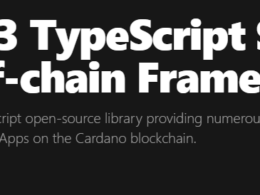One of the most promising use cases for Cardano is Web3 gaming, which leverages blockchain technology to create more immersive, interactive, and fair experiences for players. While Web3 games create thrilling experiences for the community, developing them requires a high level of technical expertise, security, scalability, and interoperability. Moreover, most existing game engines are designed for Web2 games, which rely on centralized servers and databases and do not support the features and benefits of Web3 games, such as true ownership, play-to-earn, and cross-chain compatibility.
Paima, a Web3 engine, addresses this problem by allowing developers to build on-chain Web3 games using their classic web2 stack. According to Sebastian Guillemot, one of Paima Studio’s co-founders, many companies and individual developers are trying to get into Web3 gaming but don’t necessarily know Plutus or Solidity, making it difficult for them to get into the industry. Paima is built on top of Cardano’s layer 2 solution, which enables fast and cheap transactions while preserving the security and decentralization of the layer 1 blockchain. Paima also supports cross-chain gameplay in that players can access the same game from different blockchains and wallets without compromising their identity or assets.
Here’s an overview of the Paima gaming engine and how it works.
How does the Paima Gaming Engine work?
Paima gaming engine has several key features that make it unique and powerful for Web3 game development. First, Paima allows developers to use familiar web2 tools and languages, such as JavaScript, Unity, or Game Maker, to create state machines that run on the layer 2 network. These state machines can evolve based on layer 1 events, such as new blocks, transactions, contracts, or historical data. They can also react to passive time and timers, or more complex transition rules.
Second, Paima enables stateful NFTs and NFT compression. This means that developers can use the layer 2 state machines to add extra information and functionality to the layer 1 NFTs, allowing them to change over time based on user actions or game logic. This also reduces the need to mint a lot of static NFTs on the layer 1 blockchain, saving costs and space.
Third, Paima protects users even in the case of hacks or exploits. Since the layer 2 state machines are deterministic and verifiable by anyone, any malicious or invalid transactions can be detected and reverted by the network. Moreover, users can always withdraw their assets from the layer 2 network to the layer 1 blockchain at any time, ensuring their safety and sovereignty.
Examples of Games Building on the Paima Gaming Engine
While the Paima gaming engine is still in its beta testing phase, it has already attracted several game studios and projects to build on its platform. These include:
- Wrath of the Jungle Tower Defense – A multiplayer tower defense game that uses Cardano’s native tokens as in-game currency and NFTs as towers. In the card game, players can build and defend their towers from enemy attacks. The game uses smart contracts to manage the tower construction and combat and ADA tokens to purchase new cards and upgrades.
- Chess – The popular classic board game where players can challenge each other to a strategic duel. The game uses smart contracts to enforce the rules and record the moves and ADA tokens to reward the winners.
- Jungle Wars NFT Rumble – A collectible card game where players can build their own decks of animal cards, each with unique abilities and traits. The game uses stateful NFTs to represent the cards, which can evolve and level up as the players progress.
- Stateful NFT Auto Battler – A turn-based strategy game where players can assemble a team of NFT characters, each with different skills and stats. The game uses stateful NFTs to store the character data and smart contracts to execute the battles.
Paima gaming engine is poised to revolutionize the Web3 gaming industry by bringing it to Cardano’s blockchain platform. By offering a user-friendly, secure, scalable, and interoperable solution for game development, Paima aims to empower developers and players alike to create and enjoy the next generation of Web3 games. This has already set sail, with a few funded projects within the ecosystem driving and building on this initiative. Let’s take a closer look at what we can expect over the coming months.
Paima gets integrated into more gaming engines and platforms
Currently, there exist multiple integrations of Cardano wallets through Paima into gaming systems like Unity, Game Makler, Phaser, JavaScript, and LLM AI models. This allows developers building games using these technologies to build and deploy Web3 games in the Cardano ecosystem.

The Paima Studios team aims to increase the adoption of gaming in the Cardano ecosystem by integrating Paima into more systems. According to their recently approved Fund 10 proposal, the team plans to integrate Paima into Unreal Engine, GPS connections, iOS and Android, and some Augmented Reality devices like Vision Pro. This effort will benefit the Cardano ecosystem by allowing developers to easily build their gaming business using the technology they love and still deploy their applications in the Cardano ecosystem.
On-chain gaming to leverage NFTs from the Cardano ecosystem
Paima Studios, in partnership with dcSpark, is also working on a project that will allow on-chain games deployed to the Cardano ecosystem on sidechain to access NFTs that live on the L1. It’s within the project’s scope to support NFTs from other ecosystems, thereby making it easier for developers to monetize their games. In their Fund 10 proposal, which was successfully voted on by the community, the team aims to increase the viability of Paima by allowing games deployed on the Cardano ecosystem to leverage the liquidity of an increasing number of NFT ecosystems, as well as allow Cardano NFTs to be used in games hosted in other ecosystems. The main goal is to make it easier for developers to build highly customizable on-chain games while still having access to the liquidity of the Cardano NFT market.
This initiative is a win-win for both game developers and NFT creators in that Cardano NFTs will gain value as their usage in on-chain games and autonomous worlds increases. This will also open up opportunities for game developers to attract the Cardano community to their games. On the other hand, Cardano NFTs will get minted as games that want access to a large amount of liquidity for in-game NFTs will be able to natively mint them on Cardano and then project them into their games. This will arguably grow and position the Cardano NFT ecosystem as a leader in on-chain gaming and autonomous worlds, one of the exciting domains in crypto and Web3.
The partnership between dcSpark and Paima Studios is set to bring a wide range of innovations in the Web3 gaming space to Cardano. Simplifying how we build legacy games on Cardano will open up game development to a broader audience and improve our gaming experience. We’re all excited to see what the future of web3 gaming holds for the Cardano community.










